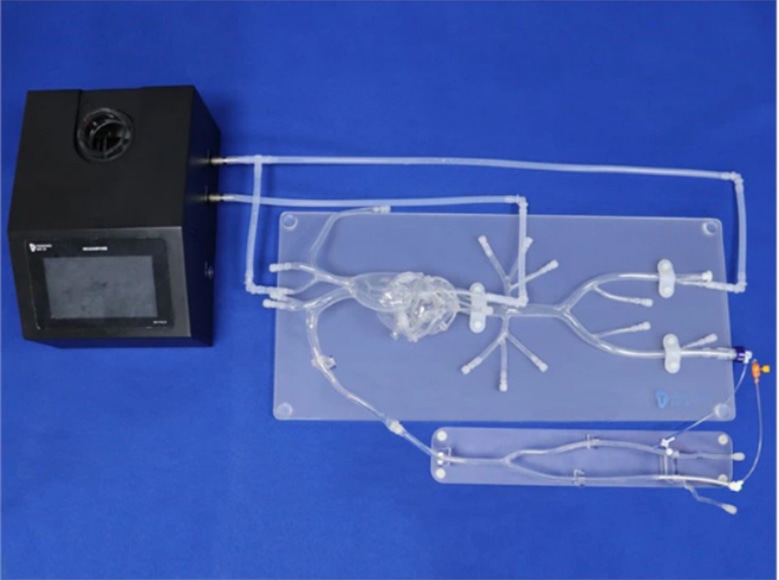
#Industry News
Unveiling Coronary Artery Spasm: Causes, Symptoms, and Management
Detachable Coronary Model
Introduction:
Coronary artery spasm, also known as variant angina or Prinzmetal's angina, is a condition characterized by the sudden constriction or tightening of the coronary arteries, which supply oxygen-rich blood to the heart muscle. This spasmodic constriction can lead to a temporary reduction or blockage of blood flow, resulting in chest pain and potentially severe complications. In this article, we explore the causes, symptoms, diagnosis, and management of coronary artery spasm.
Causes and Risk Factors:
The exact cause of coronary artery spasm is not fully understood. However, several factors and conditions can contribute to its development, including:
1.Abnormal Vascular Smooth Muscle Function: Dysfunction of the smooth muscle cells in the walls of the coronary arteries can cause exaggerated contraction and spasm.
2.Endothelial Dysfunction: Impaired function of the endothelium, the inner lining of blood vessels, may disrupt the balance of substances that regulate vascular tone, leading to spasms.
3.Smoking: Cigarette smoking is a significant risk factor for coronary artery spasm, as it can damage the endothelium and trigger spasms.
4.Drug Use: Certain drugs, such as cocaine and amphetamines, can induce coronary artery spasms.
5.Emotional Stress: Emotional stress and intense emotions, such as anxiety or anger, have been associated with the onset of coronary artery spasms.
Symptoms:
The most common symptom of coronary artery spasm is chest pain (angina), which may differ from typical stable angina. The pain is often described as:
1.Intense and Squeezing: Patients may experience a gripping or squeezing sensation in the chest, usually behind the breastbone (sternum).
2.Unpredictable Occurrence: Unlike stable angina, which is often triggered by physical exertion or stress, coronary artery spasms can occur at rest, during sleep, or even during mild physical activity.
3.Variable Duration: The chest pain caused by coronary artery spasms typically lasts for a few minutes to several minutes before subsiding.
In some cases, coronary artery spasms can lead to more severe complications, including heart attack (myocardial infarction) or life-threatening arrhythmias.
Diagnosis:
Diagnosing coronary artery spasm can be challenging, as the spasms are often transient and may not be present during diagnostic tests. However, the following methods can help in the diagnostic process:
1.Electrocardiogram (ECG): An ECG records the electrical activity of the heart and can show changes during a spasm or at rest, providing information about the heart's function and potential ischemia.
2.Coronary Angiography: This invasive procedure involves injecting a contrast dye into the coronary arteries and taking X-ray images. It can help identify any narrowings or spasms in the coronary arteries.
3.Ergonovine or Acetylcholine Provocation Test: These specialized tests involve the administration of medications (ergonovine or acetylcholine) that can induce coronary artery spasms, allowing for their detection during coronary angiography.
Management:
The primary goals of managing coronary artery spasm are relieving symptoms, preventing complications, and reducing the frequency and severity of spasms. Treatment options may include:
1.Medications:
a. Nitrates: Nitroglycerin or other nitrate medications are commonly prescribed to relieve acute episodes of chest pain by relaxing the coronary artery walls and improving blood flow.
b. Calcium Channel Blockers: These medications help relax and dilate the coronary arteries, reducing the frequency and severity of spasms.
2.Lifestyle Modifications:
a. Smoking Cessation: Quitting smoking is crucial to minimize the risk and severity of coronary artery spasms.
b. Stress Management: Adopting stress-reducing techniques, such as relaxation exercises, meditation, and counseling, may help prevent spasm triggers.
3.Coronary Artery Stenting: In severe cases or when medical therapy is ineffective, the placement of a coronary stent during angiography may be considered to alleviate spasms and restore normal blood flow.
4.Cardiac Rehabilitation: Participating in a structured cardiac rehabilitation program can help improve overall cardiovascular health, reduce risk factors, and enhance overall well-being.
Conclusion:
Coronary artery spasm, or variant angina, is a condition characterized by the sudden constriction of the coronary arteries, leading to chest pain and potential complications. While the exact cause is not fully understood, various factors such as abnormal vascular smooth muscle function, endothelial dysfunction, smoking, drug use, and emotional stress can contribute to its development. Recognizing the symptoms and promptly seeking medical attention is crucial. Through a combination of medications, lifestyle modifications, and, in severe cases, interventional procedures, coronary artery spasms can be effectively managed, providing relief from symptoms and reducing the risk of complications. Working closely with healthcare professionals and adopting a heart-healthy lifestyle are essential for individuals with coronary artery spasm to optimize their well-being and minimize the impact of this condition on their daily lives.





